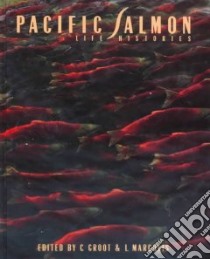Pacific Salmon - 9780774803595
Un libro in lingua di G. Groot Margolis L. (EDT) edito da Univ of British Columbia Pr, 1991
- € 129.00
- Il prezzo è variabile in funzione del cambio della valuta d’origine
Pacific salmon are an important biological and economic resource of countries of the North Pacific rim. They are also a unique group of fish possessing unusually complex life histories. There are seven species of Pacific salmon, five occurring on both the North American and Asian continents (sockeye, pink, chum, chinook, and coho) and two (masu and amago) only in Asia.
The life cycle of the Pacific salmon begins in the autumn when the adult female deposits eggs that are fertilized in gravel beds in rivers or lakes. The young emerge from the gravel the following spring and will either migrate immediately to salt water or spend one or more years in a river or lake before migrating. Migrations in the ocean are extensive during the feeding and growing phase, covering thousands of kilometres. After one or more years the maturing adults find their way back to their home river, returning to their ancestral breeding grounds to spawn. They die after spawning and the eggs in the gravel signify a new cycle. Upon this theme Pacific salmon have developed many variations, both between as well as within species.
Pacific Salmon Life Histories provides detailed descriptions of the different life phases through which each of the seven species passes. Each chapter is written by a scientist who has spent years studying and observing a particular species of salmon. Some of the topics covered are geographic distribution, transplants, freshwater life, ocean life, development, growth, feeding, diet, migration, and spawning behaviour. The text is richly supplemented by numerous maps, illustrations, colour plates, and tables and there is a detailed general index, as well as a useful geographical index.
Informazioni bibliografiche
- Titolo del Libro in lingua: Pacific Salmon
- Sottotitolo: Life Histories
- Lingua: English
- Autori : G. Groot Margolis L. (EDT)
- Editore: Univ of British Columbia Pr
- Collana: Univ of British Columbia Pr (Hardcover)
- Data di Pubblicazione: 01 Ottobre '91
- Genere: SCIENCE
- Argomento: Pacific salmon
- Dimensioni mm: 273 x 222 x 31
- ISBN-10: 0774803592
- EAN-13: 9780774803595


